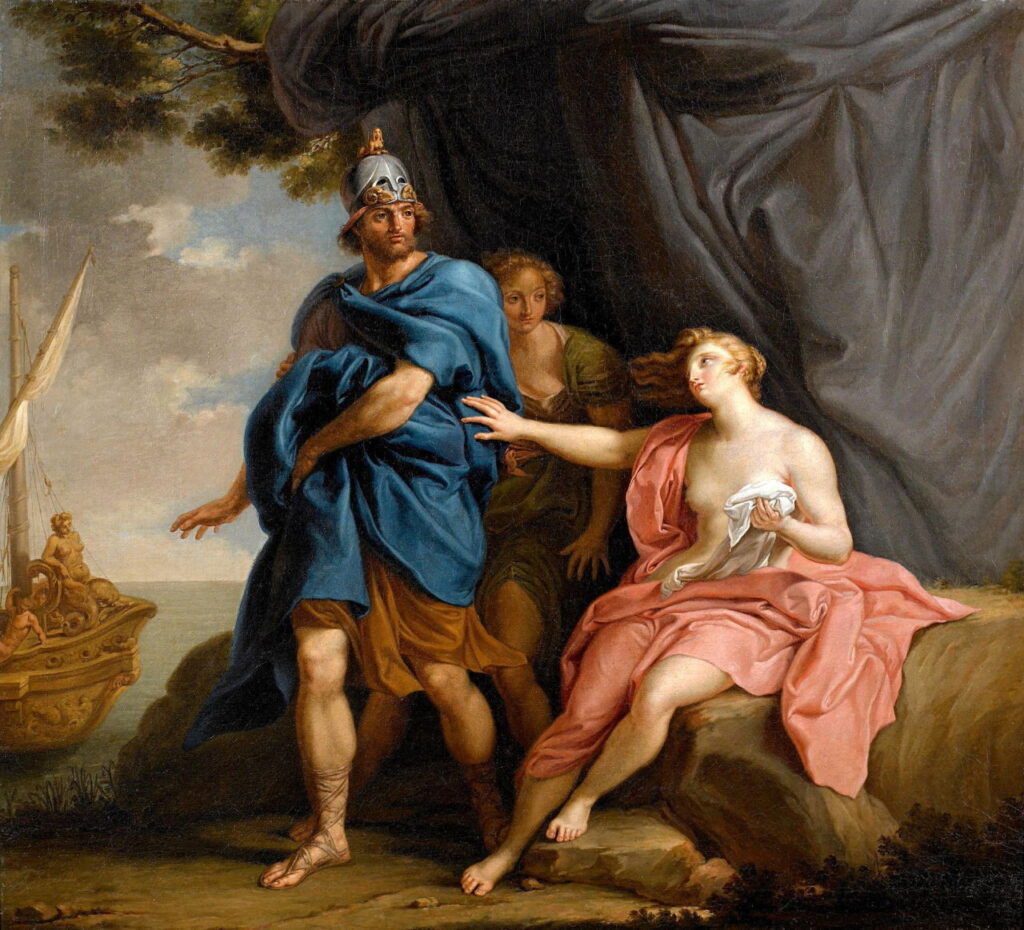Heroines 7: Dido’s doomed affair

For the last couple of millennia, the extra-marital affair of Dido Queen of Carthage and Aeneas, Trojan refugee and patriarch of the Roman Empire, must have been among the most famous. First told in explicit detail in Virgil’s epic Aeneid, it has inspired at least a dozen operas, is referred to in seven of Shakespeare’s plays, and even pops up in two of the Civilization games.
Its outline is simple, and a prototype for uncountable literary works: girl meets boy on a mission; boy cannot deviate from mission; boy leaves girl; girl dies heartbroken. Ovid’s summary in his Metamorphoses is a little longer than that, and far more eloquent and poetic. Ovid also wrote a second and fuller account in his collection of fictional letters by famous women, Heroines, and it’s that examined here.
Dido and her brother Pygmalion (not the better-known Pygmalion who fell in love with his statue) were of royal blood, probably being the children and heirs of the King of Tyre. Dido married Sychaeus, but Pygmalion wanted their riches too, so had her husband murdered when he was at the altar in their own home.
Dido took her riches and fled to North Africa, seeking sanctuary on a plot of land she acquired from the Berber king Iarbas, whom she rejected as a suitor. He gave her as much land as could be encompassed by an oxhide, so Dido ingeniously cut the oxhide up into thin strips, which she fastened end-to-end to enable her to circumscribe an entire hill.
There, Dido built the city of Carthage, into which she drew those who had fled with her, local Berbers and many others. The city grew to be wealthy and powerful, as she remained its queen.
JMW Turner (1775-1851), Dido Building Carthage, or The Rise of the Carthaginian Empire (1815), oil on canvas, 155.5 x 230 cm, The National Gallery (Turner Bequest, 1856), London. Courtesy of and © The National Gallery, London.
JMW Turner depicts this in one of his works inspired by Claude Lorrain: Dido building Carthage, or The Rise of the Carthaginian Empire (1815). Dido is on the left bank, dressed in blue, and opposite her is the monumental tomb of her husband Sychaeus.
Although a simple reading of this painting follows its title, it could equally show Aeneas as the man to the left of Dido, in which case the masts behind them would be those of Aeneas’ ships, and the painting would show their first meeting.
Aeneas was a refugee from the city of Troy, who had fled the city with his father Anchises, wife Creusa, and son Ascanius, as the city was burning and being sacked by the Greeks. Together with other refugees, Aeneas, his father and son had sailed away, then undertook a protracted journey across the Mediterranean in search of his destiny.
Pompeo Batoni (1708–1787), Aeneas Fleeing from Troy (1753), oil on canvas, 76.7 × 97 cm, Galleria Sabauda, Turin, Italy. Wikimedia Commons.
Pompeo Batoni’s Aeneas Fleeing from Troy (1753) shows the family as they leave the burning city behind them. Creusa is starting to fall slightly behind, and becoming distressed.
Aeneas’ mother was Venus, making him Cupid’s brother. Also interested in Aeneas was Juno, the senior goddess, who wanted to thwart his reaching Italy, and her husband Jupiter, who wanted Aeneas to reach his destination, where his descendants Romulus and Remus would ultimately found Rome. When Aeneas and his men left the island of Sicily heading north towards the Italian mainland, Juno intervened by bringing a northerly gale driving them south to the coast of North Africa, and the city of Carthage.
Pierre-Narcisse Guérin (1774–1833), Aeneas tells Dido the misfortunes of the City of Troy (c 1815), oil on canvas, 292 x 390 cm, Musée du Louvre, Paris. The Athenaeum.
Once ashore in Carthage, Aeneas met Dido, as shown in Pierre-Narcisse Guérin’s Aeneas tells Dido the misfortunes of the City of Troy, painted in about 1815. He told her the story of his escape from the ruins of Troy, and of his guilty secret: his wife Creusa had become separated from the rest of the family. Aeneas claimed that he had gone back to look for her, and she then appeared to him in ghostly form, telling him to leave without her, which he did.
Paul Cézanne (1839–1906), Aeneas Meeting Dido at Carthage (c 1875), watercolour, gouache, and graphite on buff laid paper, 12 x 18.4 cm, The Henry and Rose Pearlman Foundation, on long-term loan to the Princeton University Art Museum, Princeton, NJ. Wikimedia Commons.
It’s Paul Cézanne, in his watercolour sketch of Aeneas Meeting Dido at Carthage, painted in about 1875, who expresses this situation most clearly. Queen Dido is at the left, surrounded by her court. The warrior figure of Aeneas stands to the right of centre, and to the right of him is the shrouded spectre of Creusa.
Dido had sworn to her late husband that she would love no other, but as she and Aeneas got to know one another, both Juno and Venus (through her other son, Cupid) conspired to develop that into love. Venus wanted Dido to provide her son with a safe haven, and Juno wanted to halt his progress. This came to a head when the couple went out with a hunting party, and took shelter in a cave from a torrential rainstorm, brought by Juno. Both Virgil and Ovid make it explicit that they made love in that cave.
As so often happens, Dido and Aeneas made love under different assumptions. For Dido, given her commitment to her husband, she consented on the basis that this was also the act of union in marriage. For Aeneas, who had made no such commitment to his wife, who had disappeared in dubious circumstances anyway, there was no such agreement, and he remained free to pursue his destiny.
The next external influence on the couple’s relationship then came into play: Jupiter, wanting to chivvy Aeneas on his journey to start the founding of Rome and to appease Dido’s rejected suitor, sent Mercury his messenger to tell Aeneas that he must not delay with Dido, but must prepare to sail, leaving her behind. In complete secrecy, Aeneas instructed his crew to get their ship ready to resume its journey. He then went to Dido to break the news to her, only to find that she already knew of his intention to desert her and abandon her just as he had previously abandoned Creusa.
Pompeo Batoni (1708–1787), Dido and Aeneas (1747), oil on canvas, dimensions and location not known. Wikimedia Commons.
Pompeo Batoni’s painting of Dido and Aeneas (1747) draws on ambiguity in an ingenious way. It could be read as showing the couple after their lovemaking in the cave, with Dido still partly undressed, and Aeneas adjusting his clothes.
However, the presence of Aeneas’ ship in the left background implies that this is the moment that Aeneas has returned to break the news to Dido that he must sail shortly. Behind the couple is Dido’s sister Anna. In Virgil’s account, she goes to Aeneas to plead Dido’s case before the queen’s suicide; in Ovid’s version in his Heroines, Anna takes Aeneas the letter written for her by Ovid.
Dido’s letter, as supposed by Ovid, is a tour de force, and truly elegiac. It expresses her side of the story and her view of their relationship brilliantly. She points out that she could well be pregnant with a brother for Aeneas’ son Ascanius. She appeals to the emotions in a calculating and crafted way. And most of all, she raises questions about Aeneas’ abandonment of Creusa, which should have had greatest impact on his heart. No matter what Mercury might say, how could Aeneas abandon a second wife too?
But Mercury intervened again, and Aeneas was driven to sail immediately. When Dido saw this, her only option was to fall on her sword, taking her own life.
Joseph Stallaert (1825–1903), The Death of Dido (1872), media and dimensions not known, Koninklijke Musea voor Schone Kunsten van België / Musées Royaux des Beaux Arts de Belgique, Brussels, Belgium. Image by Daderot, via Wikimedia Commons.
Here I show two of the most vivid paintings of the climax of this story. In Joseph Stallaert’s The Death of Dido (1872), the queen has fallen on the sword given by Aeneas, and now lies dying on the couch on which the couple had previously made love, pointing at his ship leaving harbour by the light of the early dawn.
Resting her hand on Dido’s chest wound, her sister Anna comforts the queen in her dying moments, as the queen’s nurse and a maidservant are in attendance. There’s no sign of a funeral pyre, but suggestive smoke is made by the small altar at the extreme left.
Henry Fuseli (1741–1825), Dido (1781), oil on canvas, 244.3 x 183.4 cm, Yale Center for British Art, New Haven, CT. Wikimedia Commons.
Henry Fuseli’s Dido (1781) has mounted her funeral pyre, and is on the couch on which she and Aeneas made love. She then fell on the sword which Aeneas had given her, and that rests, covered with her blood, beside her, its tip pointing up towards her right breast.
Her sister Anna rushes in to embrace her during her dying moments, and Jupiter sends Iris (shown above, wielding a golden sickle) to release Dido’s spirit from her body. Already smoke seems to be rising up from the pyre, confirming to Aeneas that she has killed herself, as he heads towards the horizon, and history moves to the founding of Rome.
Was it Dido? Aeneas? Or the pair of them? Ovid implies, but dares not state, that it was all down to the play of the gods. Given the conflicting interests of Venus, Juno, and Jupiter, their relationship was surely doomed from the start.




